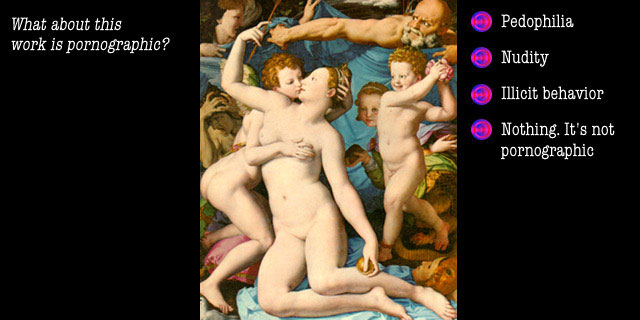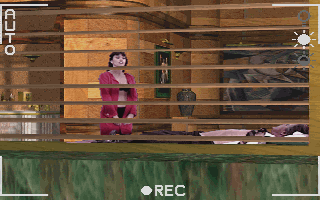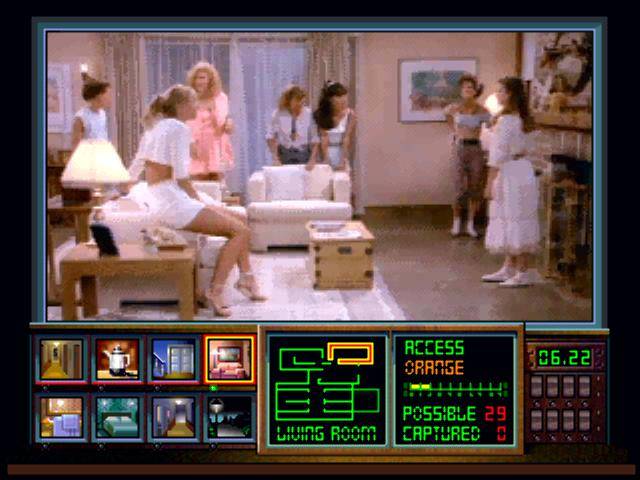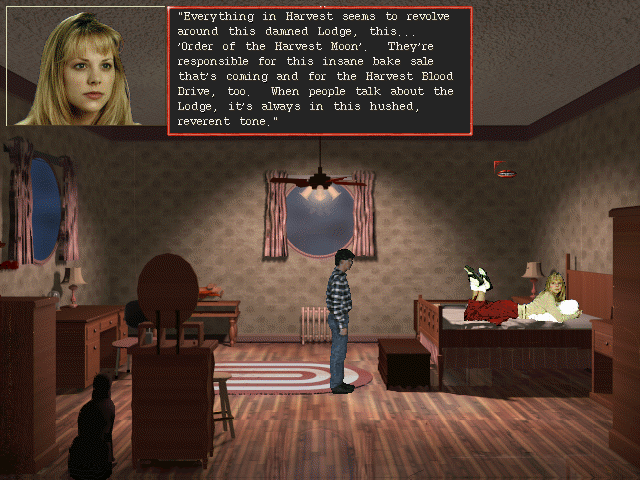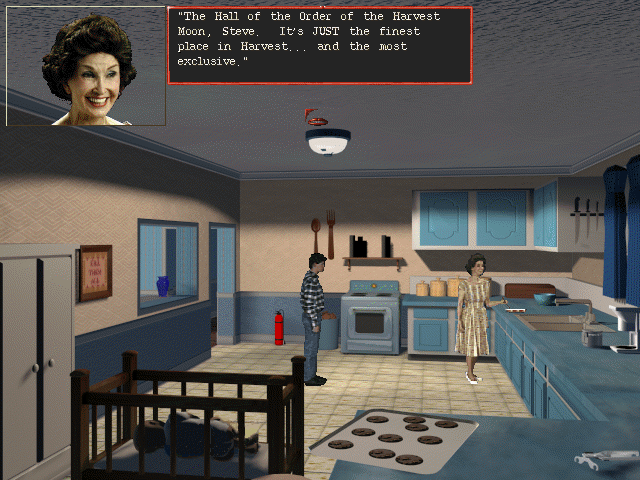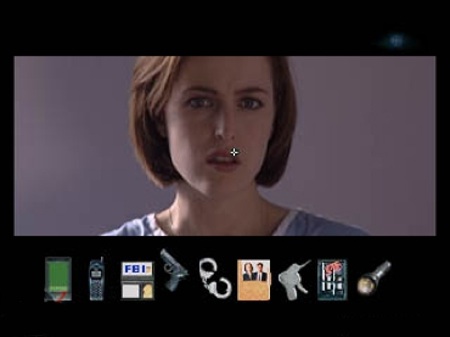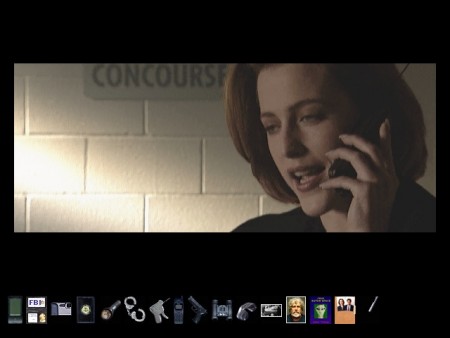So now people are talking about Her Story, a lot of them are calling it an FMV game. I don’t think I originally thought of Her Story as an FMV game — but I’ve since picked up the habit and have called it that myself a few times now. For the young, or uninitiated, the term “FMV game” (Full Motion Video game) emerged in the 90s when PCs and game machines started using CD-ROMs — opening up an unprecedented amount of storage space. The rise of digital video and this new storage capacity meant that there was a gold rush toward games that used video as their core content. What else were you going to use to fill up all that space?

Almost everyone who lived through those times carries with them a scepticism toward the FMV game, a memory that this was a fool’s gold rush. FMV games were not proper games (sound familiar?) and they were — so the historians will write — a dead end in the evolution of videogames. And yet…
And yet…
…there was something special about the FMV game. It did things and went places that we’re still not comfortable with all years later with the huge increases in gaming technology. Looking back, one of the wonderful things about FMV games is how quickly they moved to colonize genres and types of story that had always been problematic for game designers — despite their popularity in the world outside of games. Detective fiction. Psychological horror. Stories set in contemporary settings. Slasher flicks. Erotic thrillers. Many of these games were addressing an ‘adult’ audience in a way that simply hadn’t been possible before. Unfortunately, perhaps, the definition of adult would vary, often veering towards the sleazy. Because video wasn’t film. Video was video. And to the world back then, that meant a different world. Films were showing on big screens, in public. Video, video was in your home. Video was private, and as the popularity of the ‘video nasty’ and the explosion in home pornography testified to, this meant straight-to-video productions often walked the back streets of B-Movie titillation. FMV games were made by straight-to-video outfits and this was usually apparent from their production values.
Who Killed the Video Star?
The ambition of the FMV game makers was ahead of its time. The quality of the video they were actually able to put on screen was poor; they were making up the rules, inventing new ways to play without the time to make mistakes. As with early VR, these game makers didn’t have time to nail it before the world moved on. Maybe, like VR, they will get a chance again — with Youtube and mobile phones we live in a new age of Video, one that might spawn new video games. These things opened up new genres, threw out entrenched rules — they deserve our love.
As a way of discussing my relationship with this interesting piece of history, here’s my run down of my Five Notable FMV Games. It’s not a best of, because, well, there’s a lot of flawed genius in this genre…
TENDER LOVING CARE
OK, this one is a curio. A passion project from half of the creative team behind CD-ROM mega-hit The Seventh Guest. It features John Hurt as a psychiatrist and deals with a couple’s grief over the loss of their child… via the erotic thriller genre. Many actors have Japanese TV commercials they’d rather the world never see. But for John Hurt, it’s easy to imagine that it’s this role as a videogame shrink he doesn’t list on his CV. Perhaps they gave him the red sports car he drives in the intro and that kept him happy. In terms of erotic thrillers, this is the kind of thing you’d see on Channel 5 at 11:30pm starring Shannon Tweed. It’s not Bergman’s The Silence.
I only played this fairly recently, once we were almost done with Silent Hill: Shattered Memories — it had come up during development, but I didn’t want to play it until we were done with that game, to avoid any too-late-to-fix design insights. The treatment of psychiatry in the game is strange… taking itself seriously one moment, then lurching to tongue in cheek comedy the next. Its big mistake is in focusing on projective tests and open questions and then giving you multiple choice answers. In Shattered Memories, we focused on Yes/No questions or projective tests where we could accommodate an amount of analogue input from the player. Still, thanks to this game the phrase “Do you like putting big, ornate keys in old fashioned keyholes?” (said in John Hurt’s voice) has become part of mine and my wife’s sex patter.
For all its many, many failings it’s hard to hate on this game too much because of what it tries — here is a game about an adult couple dealing with grief, set in the modern, real world. Try pitching that to Game Publisher X. Also, the game establishes the player as themselves — occasionally breaking the fourth wall for both titillation and to create a dialogue about what is happening on screen. This is a key in making an FMV game tick for me — moving away form the paradigm of the player having an avatar or a direct role in the story. This should not be a given, and the best (or most promising) FMV games acknowledge this.
VOYEUR I (& II)
So here’s another erotic thriller. And it’s a perfect pitch: Rear Window meets Body Double, with some politics in the mix. Sexy, sleazy, voyeuristic. The player spies on a building through their video camera and observes the complex, murderous interactions of a group of adult human beings, in the real world. The performances and the script aren’t completely awful, and it’s kind of amazing to watch certain subject matter being broached — even if it’s entirely in the service of titillating an assumed heterosexual male audience — that even now would be difficult to broach (NB: if the treatment of bisexuality in Basic Instinct is problematic for you, this isn’t going to play well.)
Voyeur highlights one of the problems with the original FMV games — one that is entirely solvable. The concept — watching and listening, spying, from a distance — is a good one. And the execution is reasonable. The problem — and you see this time and time again with reviews of FMV Games — is one of repetition. Unlike Tender Loving Care, many of these games were still tethered to two assumptions about what a game entailed: (a) no matter how detached you are from the action, you are a character in the world and (b) there is jeopardy, pressure, threat — i.e. you can fail. So the tension in Voyeur comes from the fact that you can miss things and fail. But this means restarting the game and trying again — re-watching the same content again and again, without a fast forward button. Trial and error isn’t a fundamental sin (see: “hard games are cool again”), but the level of repetition involved here is boring*. Imagine a voyeur game in which you review the footage from a removed-in-time perspective, able to skip and move around it, without the Game Over axe hanging over your head. If anyone wants to give me the money to make it, I will make this game (the after-the-fact voyeuristic surveillance game) a hundred times over.
*The otherwise wonderful Phoenix Wright commits the same sin. Because all games have them, this lawyer/detective game gives you a health bar. If you screw up too many times you are forced to replay earlier content. It’s doubly bad because you only screw up when you’ve become stuck, having fallen between the tracks in the game’s delicate dance of suggestion and scripting.
NIGHT TRAP
This one is the big name FMV game. Laughable at points with its cheesy take on a Vampire slasher story. But it remains a killer concept. You’re spying on a house of youngsters and trying to stop them from getting eaten by balaclava’d Vampires whilst listening out for secret code words. Again, here the flaw is the repetition at its heart. It requires a level of trial-and-error and planning to navigate to its end that isn’t that far removed from the classic text and adventure games — but with the need to sit in real-time, bum-on-seat, through every attempt.
As above: I think the idea of video surveillance game using real footage is killer — more timely than ever, I mean really, incredibly timely. For that reason, and for nostalgic affection for its musical number, I love Night Trap.
(Again, there’s the titillation factor which makes it hard to be too generous about Night Trap; I’m happy to make excuses — perhaps it was impossible possible to shoot video on a 90’s Los Angeles back lot without including at least one lingerie clad actress; maybe it was a union stipulation? We can do better).
HARVESTER
Perhaps this one isn’t a true FMV Game, though it includes lot of video sequences. And they’re doozies. This was another passion project and was an attempt to push the barriers, to make a true videogame video nasty, with an enthusiasm that can be infectious. Here’s a brief list of the acts the game includes: “various scenes of violence and gore; implied sexual intercourse, masturbation and S&M; murder; suicide; child abuse; profanity; cannibalism; prostitution; pedophilia; molestation, serial killing; geronticide, vandalism, sexually transmitted diseases; and stereotypes of homosexuals, Native Americans, Italians, and others.” Clearly it’s going all out to offend and disturb.
Despite having watched a bunch of Youtube playthroughs of this game, I’ve never played it. Perhaps that’s the best way to experience it — very millennial, very video. In its ending and its surprise reveal, the game claims to be a comment on violence in videogames — casting videogames as training programmes for sociopathic men. Evergreen topicality perhaps, but it’s hard to know just how earnest this thinking is — which is perhaps true of many of the classic video nasties. They have their cake and eat it, but that lingering vagueness makes them hard to dismiss outright.
Harvester is a reminder of one aspect of the FMV era that really hasn’t aged — the withered, dithered, jerkily animated digital sprites that were used when FMV games went third person (worst offender: Sierra’s Police Quest 4). I’m starting to think that FMV games with a direct avatar are a bad idea…
X-FILES: THE GAME
I’m going to stick this one in here because it’s another fascinating curio. It’s also nice to have one game on the list whose content isn’t so problematic. It includes performances by the lead actors from the show — so we’re talking performances that work, and that evoke the level of reality that we’ve bought into from the show itself. And it’s just such a great idea — why aren’t there more games like this? You want to do a game to tie in with a show or film? Shoot the actual actors, shoot it like the show. I once interviewed the man behind the X-Files game and got the sense that by the time the game released it had missed its opportunity, the game world had moved on. It’s a shame, because it’s one of the few FMV games that really respected its material. The Goldeneye of FMV Games, perhaps.
GENERATION LOSS
Ultimately, what lingers, what feels fresh about FMV games are those instances where the designers set out to bring interactivity to the table, finding ways to inject a player into their video narratives. Starting from a blank slate, unbound by traditional paradigms. The forgettable FMV Games are often those where video is used to offer the backdrop to a traditional game (the many shooting gallery games where your job is to shoot at pieces of video; or navigate a vehicle skating across a video; or pretend you are walking through a piece of video; etc.)
The world of 2015 is a world where we can make, play and enjoy — and love — games where:
- You fill in censored words in a series of letters (Blackbar)
- You navigate a text story where the words map out the geography that the story takes place in (Device 6)
- You sit at a desk processing passports and visas (Papers, Please)
- You re-arrange picture book images in stacks and layers to create new composite pictures and reveal magical depths and hidden worlds behind the surface (Gorogoa)
This is a world where controlling a player-avatar is not a requirement. It’s a world where we are all viewers and voyeurs; where we interact with video every day without putting ourselves in it; a world where we consume videogames by watching other people play them on video. This is a world which is absolutely ready to welcome back its prodigal child. Welcome back video game, the world is ready for you now.



